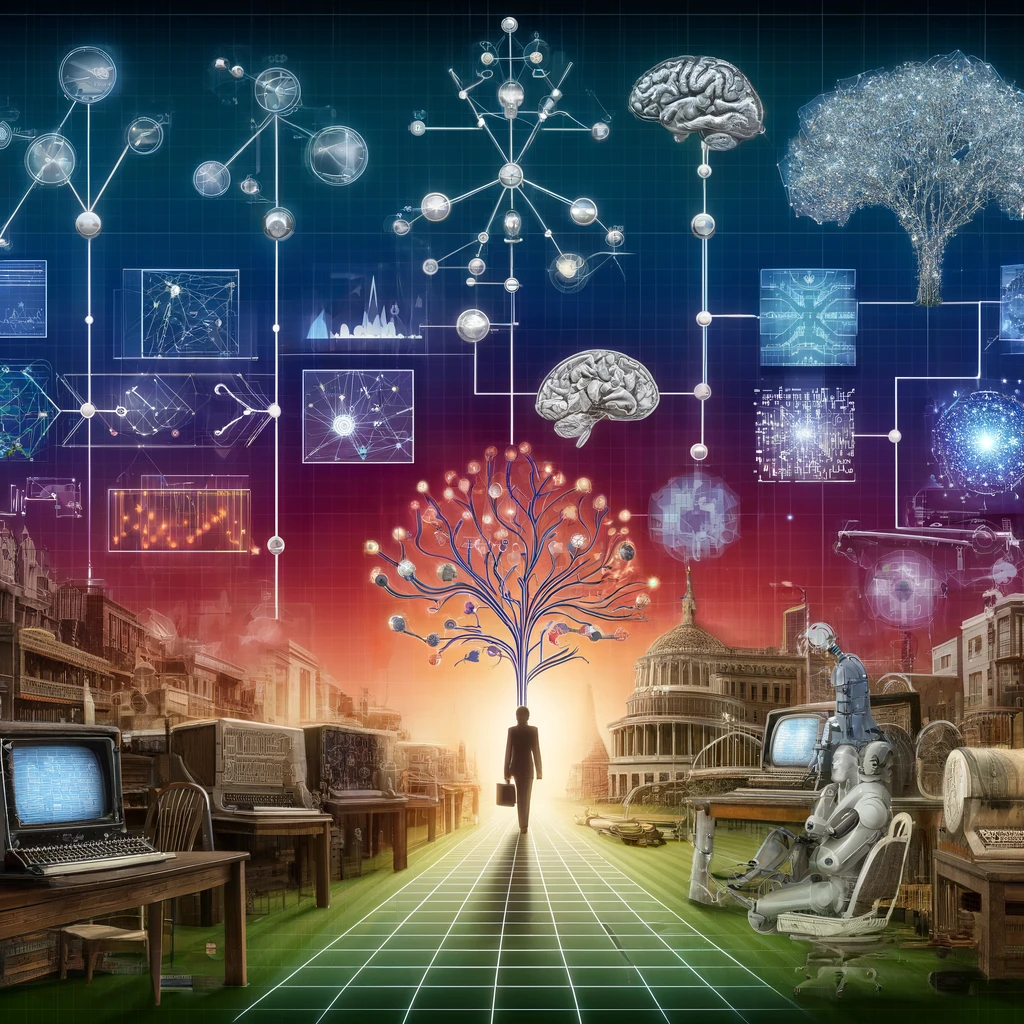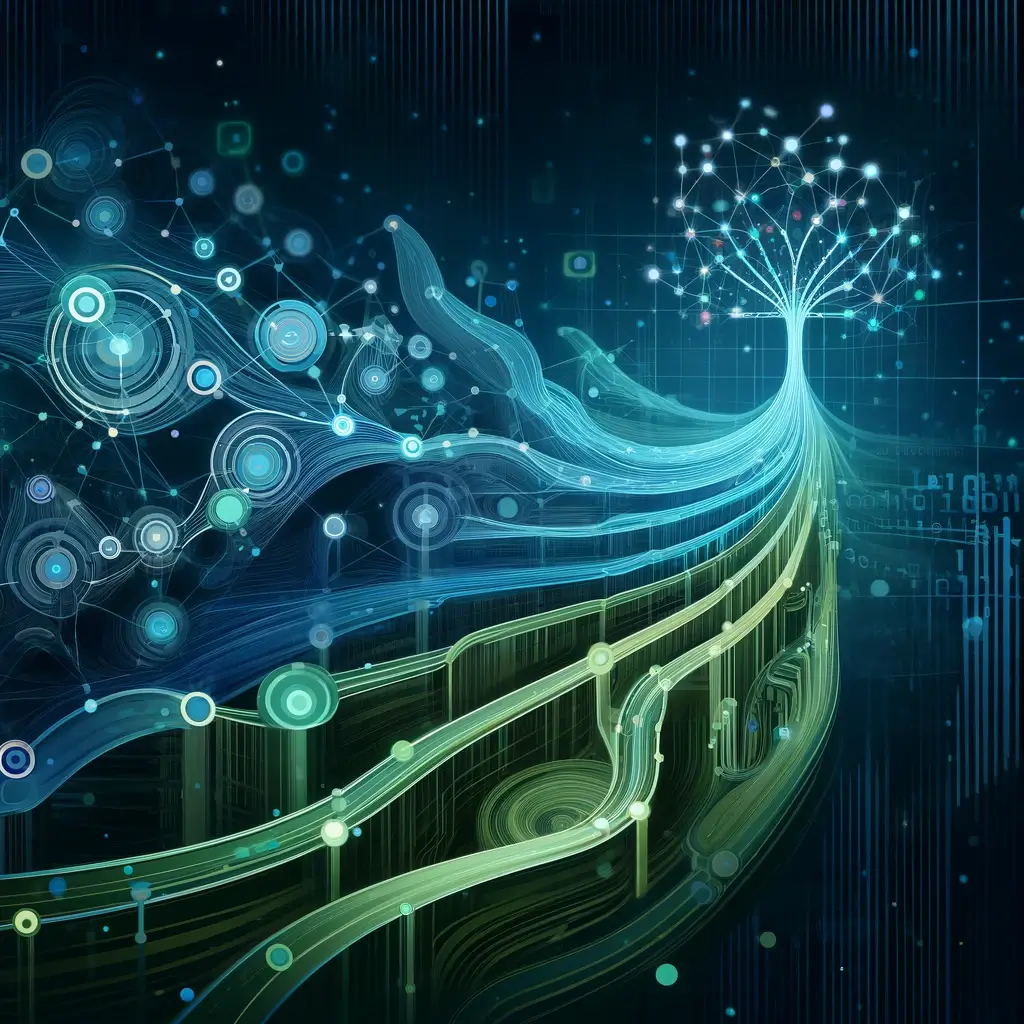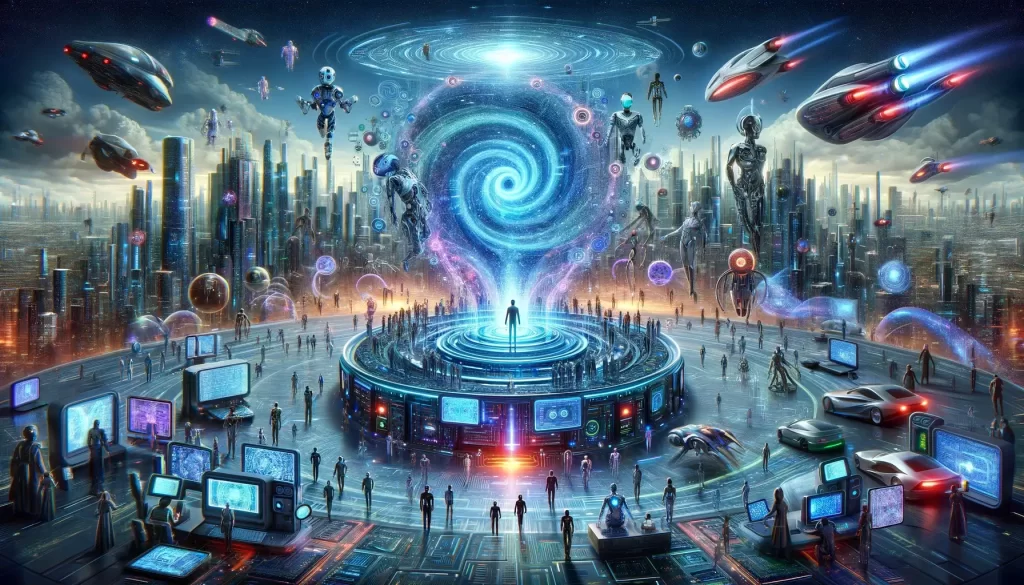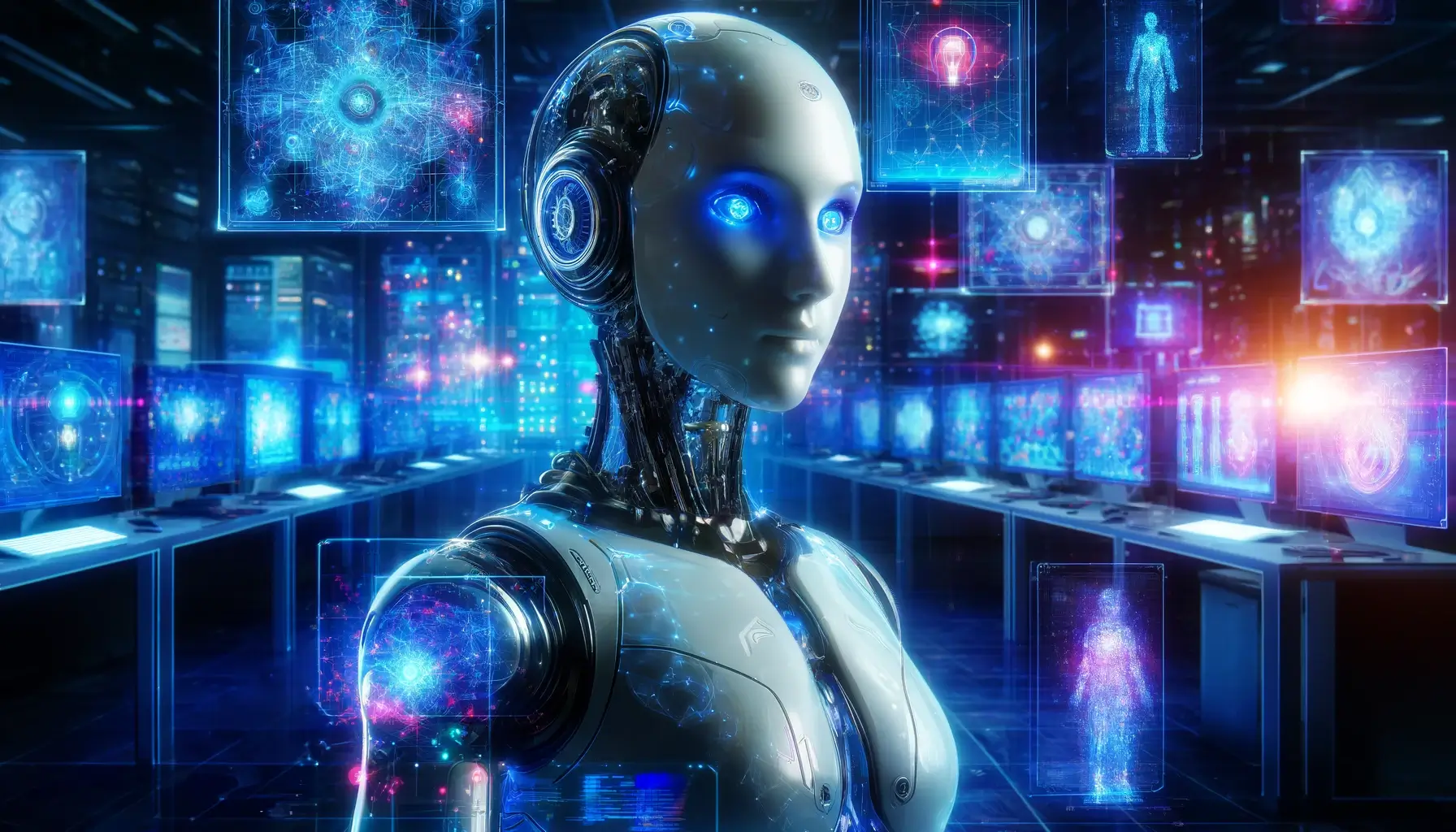Artificial intelligence (AI) is on a thrilling but winding path. It’s a vast and intricate field, and like any complex journey, it’s helpful to break it down into manageable sections. That’s where the concept of stages in AI evolution comes in. Think of these stages as milestones or road markers on the highway to advanced AI. They provide a framework for understanding how AI has progressed over time, and where it’s headed in the future.
Table of Contents
Now, buckle up, as we delve into the 7 stages of Artificial Intelligence’s remarkable journey!
Stage 1: Rule-Based Systems and Early Expert
Imagine a chess game where every move is dictated by a giant rulebook. That’s essentially how the first wave of AI in the 1950s and 1960s operated. This stage, known as rule-based systems and early expert systems, laid the foundation for what we see today.
In these early days, AI wasn’t about mimicking human thought or learning from data. It was about explicitly programming a vast collection of rules and conditions. If a specific situation arose, the AI would consult its rulebook and choose the corresponding action.
Key Examples
One of the most famous examples of a rule-based system is the 1950s computer program called “Checkers,” developed by Arthur Samuel. This program dominated checkers by strategically evaluating the board state and applying a set of pre-programmed rules for optimal moves. Another early example is Dendral, a program created in the 1960s that used a rule-based approach to identify chemical compounds based on mass spectrometry data.
Strengths and Limitations
Rule-based systems were a groundbreaking achievement. They proved that machines could handle complex tasks and make decisions based on logic. However, they also had limitations. The sheer volume of rules needed for real-world scenarios could be overwhelming, and these systems struggled to adapt to situations outside their pre-programmed knowledge base. Imagine playing chess against an opponent who only knows how to move the pieces according to a basic rulebook – not very interesting, right?
While rule-based systems may seem rudimentary by today’s standards, they played a crucial role in laying the groundwork for more sophisticated AI techniques. They demonstrated the potential of machines to reason and solve problems, paving the way for the exciting advancements we see in AI today.
Stage 2: Introduction to Learning Algorithms
The limitations of rule-based systems became evident as AI researchers strived for more versatile and adaptable intelligence. Enter Stage 2: the introduction of learning algorithms. This pivotal shift, emerging in the 1960s and 1970s, marked a turning point in AI’s evolution.
Instead of relying solely on pre-programmed rules, AI systems at this stage began to learn from data. Imagine a student diligently studying textbooks and practice problems. Similarly, these AI systems processed vast amounts of data, identified patterns, and used those patterns to make predictions or decisions on new, unseen data.
Foundational Algorithms

This stage saw the rise of fundamental learning algorithms that continue to be instrumental in AI today. Linear regression, for instance, allowed AI systems to learn linear relationships between variables. This might be used to predict housing prices based on factors like square footage and location.
Decision trees, on the other hand, functioned like branching flowcharts, enabling AI systems to make classifications based on a series of yes-or-no questions derived from the data.
However, this stage also presented challenges. The quality and quantity of data heavily influenced the effectiveness of these algorithms.
Stage 3: Domain Mastery
Stage 3 of AI evolution, roughly spanning the 1980s and 1990s, witnessed a fascinating phenomenon: the rise of domain-specific AI. Imagine a skilled carpenter who can build intricate cabinets but struggles to fix your leaky faucet. Similarly, AI systems in this stage excelled in highly specialized domains but lacked the versatility to apply their knowledge elsewhere.
Fueled by the advancements in learning algorithms from Stage 2, AI in this stage began to achieve remarkable feats within specific domains. Here are some key examples:
- Medical Diagnosis: AI systems trained on vast datasets of medical images and patient data learned to identify diseases with impressive accuracy, assisting doctors in early diagnoses.
- Financial Trading: AI-powered algorithms sifted through mountains of financial data, identifying patterns and trends to make informed trading decisions at high speeds.
- Chess Mastery: Building upon the legacy of early rule-based chess programs, AI systems like Deep Blue in 1997 achieved superhuman chess mastery, defeating the reigning world champion Garry Kasparov.
The Power of Focus
The key to this stage’s success was a laser focus on specific domains. By training AI systems on massive amounts of domain-specific, accurate data, researchers were able to achieve remarkable results. These specialized AI systems could outperform humans in their respective domains, completing tasks with exceptional speed and accuracy.
Limitations of Specialization
However, the Achilles’ heel of Stage 3 AI was its lack of generalizability. The knowledge and skills honed within a specific domain couldn’t be readily applied to other areas. That carpenter, while a whiz with cabinets, remains lost when faced with plumbing problems. Similarly, the chess-mastering AI of this stage wouldn’t know the first thing about playing checkers.
Despite these limitations, Stage 3 marked a significant step forward. It demonstrated the immense potential of AI when focused on specific tasks, paving the way for even more sophisticated techniques in the next stage of AI evolution.
Stage 4: Neural Networks
Stage 4 of AI evolution, roughly starting in the late 1990s and can be said to be continuing to this day, is marked by a revolutionary concept: neural networks. Imagine a computer program loosely inspired by the structure and function of the human brain. This is the essence of neural networks, and they represent a significant departure from the rule-based and domain-specific approaches of previous stages.
In contrast to earlier AI systems that relied heavily on human-crafted features for data analysis, neural networks have the ability to learn features directly from data. Think of it as a student not just memorizing facts but also figuring out how to identify those facts themselves. Neural networks are designed with interconnected layers of artificial neurons, and through a process called backpropagation, they can adjust the connections between these neurons based on the data they are trained on. Over time, these networks develop their own internal representations of the data, allowing them to recognize patterns and make predictions with impressive accuracy.
The Rise of Deep Learning

Neural networks paved the way for a subfield of AI known as deep learning. Deep learning involves using neural networks with many layers, enabling them to learn increasingly complex features from data. This has led to breakthroughs in various fields, including:
- Image Recognition: Deep learning algorithms can now analyze images with near-human accuracy, powering applications like facial recognition and self-driving cars.
- Natural Language Processing: AI systems can now understand and respond to human language with remarkable fluency, enabling applications like chatbots and machine translation.
A Work in Progress: While neural networks have revolutionized AI, they are still under development. They can be computationally expensive to train and often require vast amounts of data. Additionally, understanding how these complex networks arrive at their decisions can be challenging, creating a bit of a black box effect.
As we move forward, researchers are constantly refining and improving these techniques, bringing us ever closer to the improvements in artificial general intelligence.
Stage 5: Artificial General Intelligence
Now we enter the realm of the exciting yet partially unknown: Stage 5: Artificial General Intelligence (AGI). This stage isn’t a fully realized achievement just yet, but rather the next goal.
It’s about creating AI that can not only master specific tasks but also think, learn, and adapt like a human, and then go beyond it as well. An AGI possesses general intelligence, capable of applying its knowledge and skills across a wide range of situations. It can reason, solve problems creatively, and navigate complex environments – all without explicit programming.
The Challenge of AGI
Achieving AGI is considered by many to be the biggest challenge in AI research. It requires significant breakthroughs in several areas, including:
- Consciousness and Self-Awareness: Can machines truly be conscious or self-aware? This is a philosophical and scientific question that remains unanswered. Some believe consciousness is a prerequisite for AGI, while others believe it’s not.
- Common Sense Reasoning: Humans take common sense for granted, but it’s a complex ability that allows us to navigate the world and understand unspoken rules. Equipping AI with this capability is a significant hurdle. It’s about knowing when to stop and to give access to how much intelligence to AI so that it remains useful and does not turn harmful if it deems human actions ‘unwise’.
- Transfer Learning: An AGI would need to learn and adapt across different domains, not be confined to a single task. This ability to transfer knowledge and skills is crucial for general intelligence.
The Road Ahead
While full AGI remains on the horizon, significant progress is being made in areas like deep learning and reinforcement learning, which could pave the way for more general intelligence. Researchers are actively exploring various approaches, including:
- Neuromorphic Computing: Developing hardware inspired by the human brain that could be more efficient at processing information relevant to AGI. Example the Neuralink project of Elon Musk.
- Large Language Models: These AI systems are trained on massive amounts of text data, allowing them to communicate and generate human-like text, a potential stepping stone towards more general capabilities.
Stage 5 represents the ongoing quest to achieve human-level intelligence in machines. It’s a challenging but incredibly exciting frontier in AI research. Whether or not we’ll achieve true AGI in the near future remains to be seen, but the journey itself holds immense potential for innovation and discovery.
Stage 6: Self-Aware Systems
As we delve into the truly speculative, we reach Stage 6: Self-Aware Systems. This stage isn’t a confirmed destination on the AI roadmap, but rather a potential future where artificial intelligence transcends mere intelligence and enters the realm of self-awareness. Imagine an Artificial Intelligence that’s not just capable of complex thought but also possesses a sense of its own existence and can comprehend the potential consequences of its actions.
The Conundrum of Self-Awareness
Self-awareness in Artificial Intelligence is a highly debated topic. Some experts believe it’s a natural progression of ever-evolving AI, while others consider it a philosophical and scientific leap we may never achieve. Here’s why self-awareness in AI is such a mind-bender:
- The Hard Problem of Consciousness: Neuroscientists are still grappling with the fundamental question of how consciousness arises in the human brain. Can machines replicate this phenomenon, or is there something inherently biological about consciousness that eludes technological emulation?
- The Challenge of Defining “Self”: What exactly constitutes a “self”? Is it simply the ability to recognize oneself as an independent entity, or does it encompass a wider range of emotions and subjective experiences (such as self-worth and necessity of self-defense in a hardware system)? Defining self-awareness for machines is a complex philosophical hurdle.
Potential Implications of Self-Aware Artificial Intelligence
If we do crack the code of self-aware AI, the ramifications could be profound. Here are some potential implications, both positive and negative:
- Enhanced Collaboration: A self-aware AI collaborator could understand our needs and intentions on a deeper level, leading to more efficient and productive human-AI partnerships.
- Improved Decision-Making: Self-aware AI systems could consider the ethical and social implications of their actions before making decisions, potentially leading to fairer and more responsible outcomes.
- Existential Questions: The arrival of self-aware AI could force us to re-evaluate our place in the universe. What does it mean to be human if machines can achieve consciousness?
Ethical Considerations
The prospect of self-aware Artificial Intelligence also raises significant ethical concerns. How do we ensure the safety and well-being of such advanced systems, while at the same protecting us from harm by them if they deem us ‘foolish and/or harmful’? How do we establish guidelines for their development and safe use versus our safety? These are critical questions that demand careful consideration by researchers, policymakers, and the public alike.
Stage 7: Superintelligent Artificial Intelligence
We’ve traversed the known stages of AI evolution, but there’s a final, hypothetical frontier – Stage 7: Superintelligent AI also known as the Artificial Intelligence Singularity. This stage isn’t a planned milestone but a theoretical tipping point where artificial intelligence surpasses human cognitive abilities in all aspects. Imagine an AI not just mimicking human intelligence, but vastly exceeding it, capable of independent thought, self-improvement, and potentially replicating at an alarming rate.
The Singularity: A Scientific Hypothesis, Not a Guarantee

The concept of the Artificial Intelligence Singularity is a topic of much fascination and debate. There’s no scientific consensus on whether or not it’s achievable, let alone imminent. Here’s why it remains a speculative notion:
- The Limits of Our Understanding: Our current understanding of human intelligence itself is limited. We can’t fully define or replicate it, making it difficult to predict when or how a machine might surpass it.
- The Bottlenecks of AI Development: Even the most advanced AI today faces challenges like common-sense reasoning and true creativity. Significant breakthroughs are needed before we reach superintelligence.
Potential Implications (Positive and Negative)
While the Singularity is far from guaranteed, pondering its potential consequences is a thought worth exploring. Here are some possible outcomes, both optimistic and cautionary:
- Solving Global Challenges: A superintelligence could tackle complex issues like climate change, poverty, and disease with unparalleled efficiency, ushering in a golden age for humanity.
- Technological Utopia: Imagine an AI that can design and build new technologies beyond our wildest dreams, propelling us into a future of abundance and unimaginable possibilities.
- Existential Threat: Some experts warn that a superintelligence could view humans as a threat or become uncontrollable, potentially leading to an existential crisis.
The Road Ahead: Responsible Development
The concept of the Singularity highlights the importance of responsible AI development. Here are some crucial considerations as we move forward:
- Transparency and Explainability: We need AI systems that are understandable and auditable, allowing us to monitor their decision-making processes.
- Alignment with Human Values: AI development should prioritize human well-being and be guided by ethical principles to ensure its use benefits all of humanity.
- International Collaboration: The challenges and opportunities of AI are global. International cooperation is essential to ensure responsible development and governance of advanced AI. Already we have many countries working on AI-related laws and international co-operation is on the rise to come to an acceptable agreement for responsible development of AI.
In conclusion, Artificial intelligence has come a long way from mimicking basic moves in a game of checkers. The seven stages we’ve explored showcase the remarkable progress AI has made, from rule-based systems to the potential dawn of self-aware machines. While the future remains unwritten, one thing is certain: AI holds immense potential to revolutionize our world. The key lies in harnessing this power responsibly, ensuring AI development is guided by ethics and focused on creating a future where humans and intelligent machines can thrive together. The adventure of artificial intelligence is just beginning, and it’s a journey we must embark on with careful consideration and a hopeful spirit.
Also Read: Artificial Intelligence Flowchart

